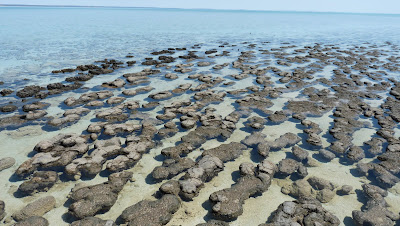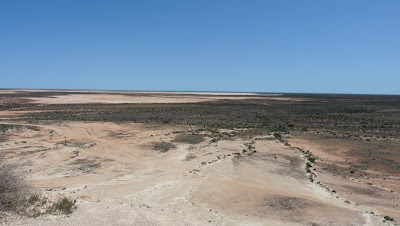
Thursday, September 30, 2010
Emu Downs Wind Farm, near Cervantes, WA


 Wind farms are becoming a common site throughout Australia...now totalling 42. This particular wind farm has 48 wind turbines and provides renewable energy electricity to run a desalination plant, 260 km (160 miles) to the south. The Kwinana Desalination Plant, which is located just south of Perth, turns water from the Indian Ocean into nearly 152 million litres (40 million gallons) of drinking water per day.
Wind farms are becoming a common site throughout Australia...now totalling 42. This particular wind farm has 48 wind turbines and provides renewable energy electricity to run a desalination plant, 260 km (160 miles) to the south. The Kwinana Desalination Plant, which is located just south of Perth, turns water from the Indian Ocean into nearly 152 million litres (40 million gallons) of drinking water per day.HMAS Sydney II Memorial, Geraldton, WA


 The HMAS Sydney II Memorial is located on Mount Scott, Geraldton in Western Australia overlooking the City and the Indian Ocean. The Memorial honours the 645 Australian sailors who were lost off the Western Australian coast during a World War II battle in November 1941. The design of the Memorial features a silver dome of 645 seagulls to represent each of the lost Sydney sailors.
The HMAS Sydney II Memorial is located on Mount Scott, Geraldton in Western Australia overlooking the City and the Indian Ocean. The Memorial honours the 645 Australian sailors who were lost off the Western Australian coast during a World War II battle in November 1941. The design of the Memorial features a silver dome of 645 seagulls to represent each of the lost Sydney sailors.Big Trucks, WA
Saturday, September 25, 2010
Hamelin Pool, WA



 Hamelin Pool is an interesting and historic place to visit. Some of the interesting sites include living marine stromatolites (single-celled blue-green bacteria). According to scientists, these stromatolites first appeared on earth about 3.5 billion years ago when there was little or no oxygen in the atmosphere. It was through the oxygen-generating activity of stromatolites that other animal life on earth was able to develop. Other interesting sites include the 1884 Telegraph Station and Hamelin Cockle quarry site, where shells have compacted to a solid mass that can be cut into blocks, which have been used for buildings in the general area.
Hamelin Pool is an interesting and historic place to visit. Some of the interesting sites include living marine stromatolites (single-celled blue-green bacteria). According to scientists, these stromatolites first appeared on earth about 3.5 billion years ago when there was little or no oxygen in the atmosphere. It was through the oxygen-generating activity of stromatolites that other animal life on earth was able to develop. Other interesting sites include the 1884 Telegraph Station and Hamelin Cockle quarry site, where shells have compacted to a solid mass that can be cut into blocks, which have been used for buildings in the general area.Thursday, September 23, 2010
Shark Bay World Heritage Area, WA



Shark Bay World Heritage Area covers more than 2.2 million hectares and has a coastline more than 1,500 km long. The westernmost part of Australia, it features landscapes and seascapes both colourful and diverse, from red and white sands and turquoise lagoons to plunging cliffs and soaring dunes. Note the shark swimming close to the shore-line.
Feeding the Dolfins at Monkey Mia, WA





 The bottlenose dolphins have been visiting the beach since the 1960's. They are wild, native to the area and yet visit of their own accord. They are fed up to three times per day, all year round. Monkey Mia has a relaxed atmosphere and those who love nature will delight at the huge variety of wildlife, the crystal waters and the pristine white shell and sandy beaches contrasting against the red soil/sand of Australia's North West.
The bottlenose dolphins have been visiting the beach since the 1960's. They are wild, native to the area and yet visit of their own accord. They are fed up to three times per day, all year round. Monkey Mia has a relaxed atmosphere and those who love nature will delight at the huge variety of wildlife, the crystal waters and the pristine white shell and sandy beaches contrasting against the red soil/sand of Australia's North West.Sunset at Denham, WA



 The small seaside village of Denham, and the caravan park that we stayed at, is the western most town and caravan park in Australia. The town also has an attractive beach with panoramic ocean views and a jetty popular with those interested in fishing and boating, and for the brave who don’t mind swimming in cooler pristine water; it is an excellent swimming spot. Denham is also the gateway for the tourists who come to see the dolphins at Monkey Mia, which is located 23 kilometres northeast of the town.
The small seaside village of Denham, and the caravan park that we stayed at, is the western most town and caravan park in Australia. The town also has an attractive beach with panoramic ocean views and a jetty popular with those interested in fishing and boating, and for the brave who don’t mind swimming in cooler pristine water; it is an excellent swimming spot. Denham is also the gateway for the tourists who come to see the dolphins at Monkey Mia, which is located 23 kilometres northeast of the town.Wooramel Coast, WA
Sunday, September 19, 2010
Port Headland, WA



 Port Hedland is one of the busiest commodity ports in the world and is the highest tonnage port in Australia. BHP Billiton exports 100 million tonnes of iron ore per annum. The port can handle, 4 large 320 metre long ships carrying up to 220 tonnes of iron ore, at one time. The port, along with the incredibly long goods trains, and the salt works, make for an impressive spectacle, however it is probably not the best place for a holiday and relaxing visit.
Port Hedland is one of the busiest commodity ports in the world and is the highest tonnage port in Australia. BHP Billiton exports 100 million tonnes of iron ore per annum. The port can handle, 4 large 320 metre long ships carrying up to 220 tonnes of iron ore, at one time. The port, along with the incredibly long goods trains, and the salt works, make for an impressive spectacle, however it is probably not the best place for a holiday and relaxing visit.Monday, September 13, 2010
Cable Beach, Broome, WA




 Cable Beach is around 22 kilometres of pure white sand set around a beautiful blue ocean backdrop. This beach is said to be one of the world’s most stunning beaches and is the perfect place for lazing about, riding along the beach on a camel or just relaxing and enjoying the stunning sunsets while enjoying a cool drink or two.
Cable Beach is around 22 kilometres of pure white sand set around a beautiful blue ocean backdrop. This beach is said to be one of the world’s most stunning beaches and is the perfect place for lazing about, riding along the beach on a camel or just relaxing and enjoying the stunning sunsets while enjoying a cool drink or two.Prison Boab Tree, Derby, WA
 The massive ancient Boab Prison Tree is believed to be around 1,500 years old and sits on the outskirts of the remote northern town of Derby in Western Australia's rugged Kimberley region. The tree is an incredible 14 metres in diameter. With its hollow centre and door cut into its side, the Boab Prison Tree was once used by early police patrols in the 1890s as a lockup for Aboriginal prisoners on their way to Derby for sentencing.
The massive ancient Boab Prison Tree is believed to be around 1,500 years old and sits on the outskirts of the remote northern town of Derby in Western Australia's rugged Kimberley region. The tree is an incredible 14 metres in diameter. With its hollow centre and door cut into its side, the Boab Prison Tree was once used by early police patrols in the 1890s as a lockup for Aboriginal prisoners on their way to Derby for sentencing.
Saturday, September 11, 2010
Mary Pool (free camp site), WA




 Mary Pool is 182km east of Fitzroy Crossing and is probably the best known and most popular overnight stop in the area. If you want to have a camp site overlooking the water, you have to arrive quite early. The causeway was covered by 10cm of water, so it is not a problem crossing the river in any type of vehicle - this may change though at various times of the year. There are very clean toilets, a shelter shed and barbecues, as well as shade trees – but no fresh drinking water. These free camp sites are the most incredibly friendly places and an evening stroll with the dog provides an opportunity to say a friendly hello to the neighbours, which can end up in a ‘happy hour’ or two. You do need to take your own fresh drinking water into any of these free camp sites and swimming in Mary Pool (or any natural waterway in the Kimberley region), is not recommended, due to the possible presence of crocodiles.
Mary Pool is 182km east of Fitzroy Crossing and is probably the best known and most popular overnight stop in the area. If you want to have a camp site overlooking the water, you have to arrive quite early. The causeway was covered by 10cm of water, so it is not a problem crossing the river in any type of vehicle - this may change though at various times of the year. There are very clean toilets, a shelter shed and barbecues, as well as shade trees – but no fresh drinking water. These free camp sites are the most incredibly friendly places and an evening stroll with the dog provides an opportunity to say a friendly hello to the neighbours, which can end up in a ‘happy hour’ or two. You do need to take your own fresh drinking water into any of these free camp sites and swimming in Mary Pool (or any natural waterway in the Kimberley region), is not recommended, due to the possible presence of crocodiles.













